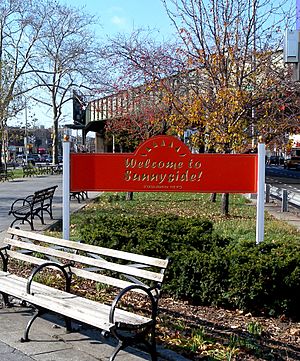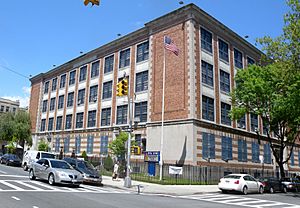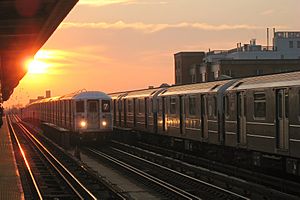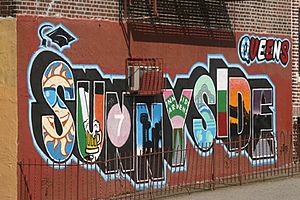Sunnyside, Queens facts for kids
Quick facts for kids
Sunnyside
|
|
|---|---|
|
Neighborhood of Queens
|
|
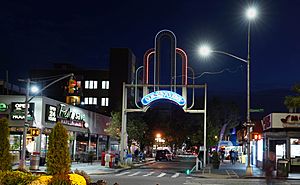
The gantry over 46th Street at Queens Boulevard is located in the heart of Sunnyside
|
|
| Country | |
| State | |
| City | New York City |
| County/Borough | Queens |
| Community District | Queens 2 |
| Named for | Sunnyside Hill Farms |
| Population | |
| • Total | 63,271 |
| Time zone | UTC−05:00 (EST) |
| • Summer (DST) | UTC−04:00 (EDT) |
| ZIP Codes |
11101, 11104, 11377
|
| Area codes | 718, 347, 929, and 917 |
Sunnyside is a lively neighborhood located in the western part of Queens, one of New York City's five boroughs. It borders other neighborhoods like Hunters Point, Long Island City, Astoria, Woodside, and Maspeth. Sunnyside is famous for the Sunnyside Gardens Historic District, which was one of the very first planned communities in the United States.
The name "Sunnyside" comes from the Bragaw family, who bought the land in 1713 and named their property "Sunnyside Hill." Back then, Sunnyside was mostly made up of small farms and marshy areas. It became part of Long Island City in 1870. After the Queensboro Bridge was finished in 1909, Sunnyside grew into a place where people lived and commuted to work in other parts of the city. Many of the six-story apartment buildings you see today were built in the 1920s and 1930s.
Sunnyside is part of Queens Community District 2. Its main ZIP Codes are 11101, 11104, and 11377. The neighborhood is kept safe by the New York City Police Department's 108th Precinct.
Contents
People and Culture
In 2010, about 63,271 people lived in Sunnyside. The neighborhood is known for being very diverse, with people from many different backgrounds living there. This includes people of Asian, African American, Native American, and Hispanic or Latino heritage, as well as non-Hispanic White residents.
The people of Sunnyside and nearby Woodside generally live longer than the average New Yorker, with an average life expectancy of 85.4 years. Most residents are adults and young people. About 17% are under 18, 39% are between 25 and 44, and 24% are between 45 and 64.
Sunnyside is a great example of how diverse Queens is. You can find people from all over the world here, including those with Albanian, Argentine, Chinese, Colombian, Filipino, Greek, Indian, Irish, Italian, Japanese, Korean, Mexican, Polish, Puerto Rican, and Turkish roots, among many others. This mix of cultures means there's a wide variety of ethnic foods to enjoy. Every spring, there's a special event called "Taste of Sunnyside" where you can try dishes from many local restaurants.
Safety Services
Sunnyside has dedicated fire stations from the New York City Fire Department (FDNY) to keep residents safe. These include:
- Engine Co. 325/Ladder Co. 163 at 41-24 51st Street
- Engine Co. 259/Ladder Co. 128/Battalion 45 at 33-51 Greenpoint Avenue
Mail and ZIP Codes
Sunnyside uses three different ZIP Codes depending on the exact location. The area west of 39th Street is 11101. Sunnyside Gardens is in 11104. The area east of 45th Street is 11377. The main United States Post Office for Sunnyside is located at 45-15 44th Street.
Learning and Schools
Sunnyside and Woodside have a good number of residents who have gone to college. About 45% of adults aged 25 and older have a college degree or higher. Students in Sunnyside and Woodside are doing well in school. The percentage of elementary school students who are good at math went up from 40% in 2000 to 65% in 2011. Also, 86% of high school students in the area graduate on time, which is higher than the city average.
Local Schools
Sunnyside has several public schools for different age groups:
- PS 150 Sunnyside (for grades PK-6)
- PS 199 Maurice A Fitzgerald (for grades PK-5)
- IS 429 (for grades 6-8)
- IS 125 Thomas J McCann Woodside (for grades 6-8)
- Robert F Wagner Junior Secondary School-Arts and Technology (for grades 6-12)
- PS 343 The Children's Lab School (for grades K-5)
- Academy of Finance and Enterprise (for grades 9-12)
- Aviation Career & Technical Education High School (for grades 9-12)
- Queens Vocational and Technical High School (for grades 9-12)
Public Library
The Queens Public Library has a branch in Sunnyside. It is located at 43-06 Greenpoint Avenue, where you can find books, computers, and other resources.
Community Life
Sunnyside has several organizations that help the community:
- Sunnyside Community Services - located at 43-31 39th Street
- Sunnyside Chamber of Commerce - helps local businesses
Places of Worship
Sunnyside is home to many churches and temples that serve its diverse religious communities:
- New York Presbyterian Church, at 43-23 37th Avenue, is in a building that was once a laundry factory built in 1932.
- Mosaic West Church and Community Center, at 46-01 43rd Avenue, helped the community by hosting a volunteer-run food pantry during the COVID-19 pandemic.
- Islamic Institute of New York, at 55-11 Queens Boulevard
- Sunnyside Muslim Center, at 39-18 47th Ave
- Queen of Angels Church, at 44-04 Skillman Avenue
- Sunnyside Reformed Church, at 48-03 Skillman Avenue, has been serving Queens for over 125 years.
Parks and Fun
Sunnyside has several parks where you can relax and play:
- L/Cpl. Thomas P. Noonan Playground, located between Greenpoint Avenue, 42nd Avenue, 43rd Street, and 47th Streets. This park honors Thomas P. Noonan Jr., a local hero who served in the Vietnam War.
- Torsney Playground, at Skillman Avenue and 43rd Street. It was built in the 1950s and honors George F. Torsney, a local politician and World War I veteran.
- Sabba Park, located in the middle of Queens Boulevard between 48th Street and 49th Street. It honors Joe Sabba, a World War II veteran.
Getting Around Sunnyside
Sunnyside is well-connected by public transportation. You can take the 7 train train on the New York City Subway's IRT Flushing Line. There are three subway stations in Sunnyside: 33rd Street–Rawson Street, 40th Street–Lowery Street, and 46th Street–Bliss Street. Several bus lines, including the Q32, Q39, Q60, Q104, B24, also run through the neighborhood.
For car travel, Sunnyside is connected to Manhattan by the Long Island Expressway and the Queens Midtown Tunnel. It's also linked to Brooklyn by the Brooklyn-Queens Expressway.
Sunnyside is also known for the large Sunnyside Yard, which is a place where Amtrak and New Jersey Transit trains are stored and prepared before they go to Penn Station in Manhattan. There are plans for a new train station in Sunnyside at Queens Boulevard, which will make it even easier for residents to get to Midtown Manhattan with just one stop.
Famous People from Sunnyside
Many interesting people have lived in or been connected to Sunnyside. These include actors like Perry Como, Nancy Walker, Judy Holliday, and James Caan. Artists like Raphael Soyer and writers such as Lewis Mumford and Suze Rotolo also called Sunnyside home.
The famous punk rock band The Ramones played some of their first concerts in Sunnyside pubs in the 1970s. Before World War II, New York Giants football star Hap Moran coached a youth football team called the Mustangs in Sunnyside Park. The legendary jazz musician Bix Beiderbecke passed away in Sunnyside, and there's a special plaque honoring him.


